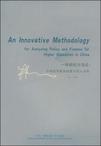一种新的方法论
出版时间:2006-11 出版社:中央广播电视大学出版社 作者:林一 页数:299
内容概要
《一种新的方法论:中国高等教育政策与投入分析》通过考察中国自改革开放政策以来,高等教育经费从单一的政府投入过渡到多渠道的投入(政府拨款、学费、高等学校自筹、社会捐集资及其他)这一政策制定过程和多元化投入体制的形成,以及多元化投入政策与机制在同时期高等教育改革与发展整体政策的相互作用下对高等学校及高等教育发展带来的冲击与产生的影响,有创见的将切克兰德的软系统方法论与现代复杂系统方法论及伯顿·克拉克的高等教育系统思想有机的结合起来,建立了在复杂的、不确定的社会背景下,中国经济转型期高等教育政策与投入问题分析的概念模型,并运用该概念模型,将高等院校作为研究载体,采用宏观分析与案例分析相结合的方法,将传统的经济学理论,如人力资本理论、公共产品理论、高等教育成本分担理论,与复杂系统科学原理的层次性、自组织性、涌现性相结合,分析和探讨了多元化投入政策的起源、实施和高等院校对政策变迁的反应,发现了高等院校及其经费来源构成的层次特性及其影响因素,得出了重要结论:经费来源构成的层次性是社会主义初级阶段市场机制开始作用但又不完全作用的产物,在市场机制不完善的条件下,政府干预强于市场作用时,层次性向较低能级发展,表现为明显的有限多层次,当市场作用强于政府干预时,层次性向较高能级发展。
作者简介
林一,工学学士,工学硕士,哲学士资深记者、学者、电视制片人中国电视艺术家协会会员,中国纪录片学术委员会理事联合国第四届世界电视论坛中国代表英国高等教育研究会会员,北京大学德国研究中心特聘研究员先后就职于大学、国家政府机关、媒体。
书籍目录
1 导言1.1 研究背景1.2 研究目的1.3 本书结构2 中国高等教育的变迁2.1 改革开放前的中国高等教育简要回顾2.2 改革开放以来的社会变迁2.2.1 经济体制改革2.2.2 政治体制改革2.2.3 对外开放2.2.4 价值重构2.3 改革开放与国际环境对中国高等教育的冲击2.4 高等教育投入体制改革与多元化投入政策3 高等教育投入问题的理论基础与尚未解决的问题3.1 世界高等教育经费来源的多元化3.1.1 人力资本理论与高等教育投资主体的多元化3.1.2 成本分担理论与投资主体的划分3.1.3 政策与市场的作用3.2 中国高等教育投入体制变迁的理论基础3.2.1 理论背景3.2.2 中国高等教育投入的多元化体制3.2.3 研究背景及研究问题的复杂性3.2.4 系统的复杂性思考3.3 本书的研究问题4 一种新的方法论4.1 系统思想方法论4.1.1 宏观综合与微观分析相结合4.1.2 定性研究与定量描述相结合4.1.3 系统的演化与复杂性4.2 比较研究方法论4.3 高等教育经济学方法论4.4 一个新的概念模型及其分析框架4.4.1 一个新的概念模型4.4.2 概念模型的分析框架4.4.3 概念模型和分析框架中的术语解释4.5 信息需求4.6 研究方法4.6.1 文档追踪4.6.2 案例研究4.6.3 有设计的采访4.6.4 比较4.7 数据采集4.7.1 案例研究院校的选择4.7.2 多样本分析院校的选择4.7.3 采访对象的选择4.8 数据分析程序4.9 局限性5 多元化投入政策的起源与实施5.1 政策变迁的过程5.2 政策变迁的理论基础5.2.1 高等教育的个人和社会收益与成本分担和补偿5.2.2 高等教育扩张与财政短缺5.3 多元化投入政策的内涵5.4 多元化投入政策的目的5.5 多元化投入政策的实施措施5.5.1 扩大资源5.5.2 提高效益6 案例研究6.1 不同类别高等院校案例分析6.1.1 案例Al6.1.2 案例A6.1.3 案例B6.1.4 案例C6.1.5 案例C2,C3和C6.1.6 不同案例院校的经费来源构成比较6.1.7 案例分析的初步结论6.2 不同类别高等院校多样本分析6.2.1 不同案例院校组的经费来源构成6.2.2 三组案例院校经费来源构成的比较6.2.3 经费来源及其构成的影响因素6.2.4 多样本分析的结论6.3 中国高等教育的经费来源构成6.4 小结7 经费来源构成及其层次性的影响因素分析模型7.1 影响因素的三力综合7.2 均方差与层次性7.2.1 均方差与政府力量的相对性7.2.2 均方差与市场力量的相对性7.2.3 均方差与学术力量的相对性……8 结论与政策建议参考文献附录
章节摘录
Under centralism and the planned economy system, supply-and-demand inhigher education is totally dependent on governmental decision-making. The government takes charge of higher education, invests in higher education, and plans student recruitment as well as arranging jobs for graduates according to the demand for talent of national development objectives. Therefore, the government exerts highly centralized power. It is not only the supply main agent, but also the demand main agent. Thus, it is a state monopolized higher educational supply- and-demand relationship.(Wang, S.1996) As mentioned above, the economic system reform experienced several stages. These include the early growth and build of township and village enterprises, the establishment and growth of special economic zones, the later joint-stock reform of state-owned enterprises, the emergence and development of private enterprises, joint-venture enterprises and the foreign enterprises. The essential feature of these reforms is that enterprises became independent legal entities outside the planned economy, The impact on higher education is that these enterprises have their own right to determine their demand for high-quality labour and can attract talents with high salaries. Since the middle of the 1980s, many university graduates voluntarily gave up their state assigned jobs, and have begun to look for jobs on their own. Therefore, the enterprises become the main demand agent for higher education. Meanwhile, with the development of economic system reform and the formation of the market system, the Chinese economy develops rapidly, and the demand of the labour market for high-quality talents changes the traditional "going to college is a privilege" , into "going to college is not only a means to change personal identity, but also an important way to obtain economic benefits",so as to stimulate personal demand for higher education, and to make individuals the main agent of demand. ……
图书封面
评论、评分、阅读与下载
